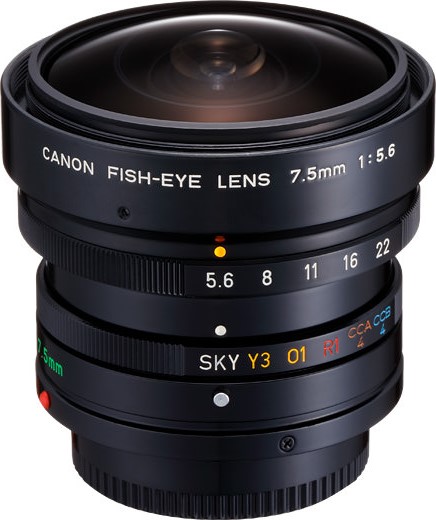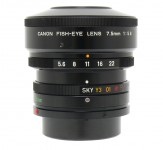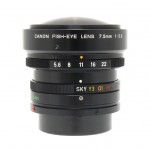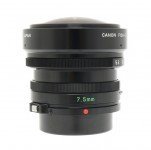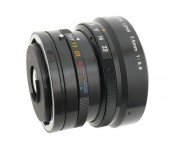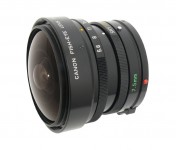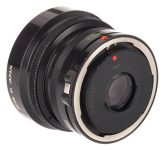Canon FDn 7.5mm F/5.6 Fisheye
Fisheye lens • Film era • Discontinued
- Announced:
- · June 1979
- Production status:
- ● Discontinued
- Country of design:
- · Japan
- Original name:
- · CANON FISH-EYE LENS FD 7.5mm 1:5.6
- Class:
- · Slow full-frame circular fisheye lens
- · Professional model (Top class)
- System:
- · Canon FD (1971)
Abbreviations
| FD | The lens is designed for Canon 35mm film SLR cameras with the Canon FD mount. |
| n | (Unofficial acronym) A new generation of FD series lenses without the breech-lock ring. |
| FISHEYE | An ultra-wide angle lens with strong uncorrected barrel distortion and extreme angle of view. |
Model history (3)
| ■Canon FD 7.5mm F/5.6 Fisheye | M | 11 - 8 | 0.30m | -- | 1971 ● | |
| ■Canon FD 7.5mm F/5.6 S.S.C. Fisheye | M | 11 - 8 | 0.30m | -- | 1973 ● | |
| ■Canon FDn 7.5mm F/5.6 Fisheye | M | 11 - 8 | 0.35m | -- | 1979 ● | |
Specification
| Optical design: | |
| 35mm full frame | |
| 7.5mm | |
| F/5.6 | |
| 11 elements in 8 groups | |
| Fixed focus | |
| Circular fisheye | |
| Canon FD [42mm] | |
| 180° | |
| Diaphragm mechanism: | |
Diaphragm type: | Manual |
Aperture control: | Aperture ring |
| 6 (six) | |
| Focusing: | |
| 0.35m | |
| <No data> | |
Manual focus control: | None |
| Physical characteristics: | |
| 365g | |
| ⌀72×62mm | |
| Accessories: | |
| Removable front filters are not accepted | |
| Built-in SKY, Y3, O1, R1, CCA4, CCB4 (part of the lens optical system) | |
| Not available | |
| Canon Extender FD 2X-B → 15mm F/11.2 |
Sources of data
- Canon FD interchangeable lenses booklet (PUB. IE01-075) (May 1979).
- Lens Wonderland. Canon FD lens guide book (PUB. C-IE-097AZ) (May 1987).
- Specifications of Canon New FD lenses (PUB. C-II-099B) (July 1981).
- Canon FD interchangeable lenses booklet (PUB. C-IE-075AF) (May 1981).
- Lens Work. The Canon guide to interchangeable lenses and Single Lens Reflex photography.
- Quick reference guide.
- Canon AE-1 Program booklet (PUB. C-CE-124) (December 1980).
- Canon AL-1 Quick focus booklet (PUB. C-CE-135A) (January 1982).
- The New F-1 World booklet.
- Canon A-1 booklet (PUB. C-CE-0990) (September 1980).
- Canon AE-1 booklet (PUB. C-CE-1056AB) (September 1980).
- Canon FD lenses sales guide.
- Canon Reflex 1981/1982 booklet.
- Canon interchangeable lenses FD booklet (PUB. C-IE-075AQ) (March 1982).
- Canon Reflex booklet (1985).
- Canon FD lenses instructions (PUB. II01-061I) (July 1979).
- Canon FD interchangeable lenses booklet (PUB. C-IE-075AL) (December 1981).
- Canon AE-1 booklet (PUB. C-CE-1056Y) (February 1980).
- Canon Products Guide (PUB. C-CE-114BI) (February 1983).
- Canon Products Guide (PUB. CE01-114B) (July 1979).
- Canon FD lenses (October 1982).
Manufacturer description #1
A circular fish-eye which covers its 180-degree angle of view in a 23mm circle within the 35mm frame. Despite its very short focal length, its retrofocus design means that the camera mirror, instead of having to be locked up before mounting, remains conveniently in position for viewing. With limitless depth of field, it promises sharp reproduction at any shooting distance or aperture, and, consequently, neither needs nor has a focusing mount. Equidistant projection over its entire angle of view makes it very appropriate for certain types of scientific photography; for the less scientifically-inclined, an exciting special effects lens. With manual diaphragm and six built-in filters (SKY, Y3, O1, R1, CCA4, CCB4).
Manufacturer description #2
Conceived for astronomical and meteorological uses, this lens has a 180 degrees angle of view in a 23mm diameter circle. All lines with the exception of those passing through the lens' horizontal and vertical center follow the natural curve of the circular image.
Its retrofocus design eliminates the need to lock the camera's mirror up. This permits uninterrupted viewing and is especially valuable given the unusual perspective inherent in this lens. Focusing is unnecessary due to its tremendous depth of field consequently a focusing mechanism is not incorporated. With a close minimum focusing distance of 35cm and correction of aberrations, particularly astigmatism and coma, sharp results are attained at any aperture and virtually any shooting distance.
Using a rotating turret, the Fisheye 7.5mm lens features six built-in filters, Sky, Y3, O1, R1, CCA4 and CCB4. Its extremely wide angle of view does not permit the use of a lens hood. Manually-operated diaphragm with stopped-down metering.
Manufacturer description #3
Looking through the viewfinder of a camera equipped with a 7.5mm fisheye lens is startling. You see everything from the ground at your feet (and perhaps your feet, too), to the sky overhead and virtually everything to your right and left within a radius of 180 degrees. The image in the viewfinder is circular and that's the way it will be reproduced on film. The fisheye lens' view is like that of a fish looking through the water to the surface. Because of the refraction between water and air the fish has a tremendously wide angle of view. The front element of a fisheye lens has an extreme amount of curvature which accounts for its 180 degrees vision. The large, concave lens in front covers the subject area and then bends the light into approximately a 90 degrees cone. The convex lens at the rear then forms the image on film. The same degree of coverage in a conventionally designed lens would require a much larger image area. Instead, with this lens, a limited circular image is projected on film. Due to the small image area, straight lines are rendered in a barrel or arch shape. Using the equidistant projection method, this circular image fisheye with its 7.5mm focal length compresses the 180 degrees field into a 23mm diameter circle.
Originally designed for scientific studies, the 7.5mm fisheye was once called the full sky lens. It was primarily used for astrophotography and astronomical observations. Today, however, the fisheye is widely used by professional photographers when special effects are desired.
Imaginative use of the fisheye can create a world of mystery from the most conventional subject matter.
The fisheye lens bends straight lines, whether vertical or horizontal. However, lines at the center of the image show little or no distortion. If you want to emphasize the special effects of the fisheye using familiar subjects, choose a scene with a predominance of straight lines - particularly away from the center of the subject area. Curved or rounded objects may exhibit some fisheye effect in the photograph, but often not to a marked degree.
While there is no focusing mechanism on the 7.5mm fisheye, it can be used effectively for close focusing. The extremely short 7.5mm focal length and f/5.6 aperture combine to provide tremendous depth of field.
With a fisheye you must keep in mind that you're shooting with a lens that covers a field of view of 180 degrees. Check the finder for the intrusion of unwanted objects such as your feet, tripod legs or even part of the camera strap. its extremely wide angle of view doesn't permit the use of a lens hood hence it cannot be protected from the direct rays of the sun or bright backlight. However, the sun can often be included effectively in the photograph.
Manufacturer description #4
This new lens is one of the most compact circular-image fish eye lenses available today...
It is particularly sharp and well corrected for color aberrations, in addition to having excellent performance at any distance.
Focusing is unnecessary because of the inherently great depth-of-field of this focal length. Since it is of retrofocus design, it does not require mirror lock-up. It is an ideal lens for the photographer seeking dramatic effects as well as the scientist or technical photographer needing a hemispherical lens for special observations.
Typical characteristics of fisheye lenses
- Extreme angle of view (at least 180° diagonally);
- Circular types (the image circle of the lens is inscribed in the image frame) or diagonal types (cover the entire image frame);
- Usually of equidistant projection type, with the distance from the picture center to any given point always proportional to the angle from the optical axis to that point;
- Huge barrel distortion;
- Short closest focusing distance (0.20 - 0.30m with 35mm full-frame prime lenses);
- Very large depth of field, eliminating the need for autofocus or precise manual focusing;
- Due to the extreme angle of view and convex front element, front filters cannot be used;
- Often equipped with a filter turret with swivel-mounted filters;
- Often come with a small, built-in petal-shaped lens hood.
Other fisheye lenses in the Canon FD system
| ■Canon FD mount (4) | |||||||||
| Canon FD 7.5mm F/5.6 Fisheye | M | 11 - 8 | 0.30m | -- | 1971 ● | ||||
| Canon FD 7.5mm F/5.6 S.S.C. Fisheye | M | 11 - 8 | 0.30m | -- | 1973 ● | ||||
| Canon FD 15mm F/2.8 S.S.C. Fisheye | A | 10 - 9 | 0.30m | -- | 1973 ● | ||||
| Canon FDn 15mm F/2.8 Fisheye | A | 10 - 9 | 0.20m | -- | 1980 ● | ||||
Lenses with similar focal length
| ■Canon FD mount (3) | |||||||||
| Sigma MF 8mm F/4 Fisheye | A | 10 - 6 | 0.20m | -- | 1988 ● | ||||
| Sigma MF 8mm F/4 Fisheye ZEN | A | 10 - 6 | 0.20m | -- | 1992 ● | ||||
| Sigma MF 8mm F/4 Filtermatic Fisheye | A | 11 - 7 | 0.20m | -- | 1982 ● | ||||
| ■Interchangeable mount (2) | |||||||||
| BelOMO Peleng A 8mm F/3.5 Fisheye MC [T] | P | 11 - 6 | 0.22m | -- | ● | ||||
| Spiratone 7mm F/5.6 Fisheye [T] akaHanimex 7mm F/5.6 Fish-eye | P | ? - ? | -- | ● | |||||
